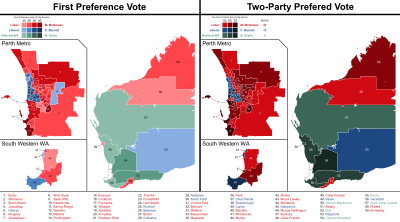| |||||||||||||||||||||||||||||||||||||||||||||||||||||||||
All 59 seats in the Western Australian Legislative Assembly and all 36 members in the Western Australian Legislative Council 30 Assembly seats were needed for a majority | |||||||||||||||||||||||||||||||||||||||||||||||||||||||||
|---|---|---|---|---|---|---|---|---|---|---|---|---|---|---|---|---|---|---|---|---|---|---|---|---|---|---|---|---|---|---|---|---|---|---|---|---|---|---|---|---|---|---|---|---|---|---|---|---|---|---|---|---|---|---|---|---|---|
| Opinion polls | |||||||||||||||||||||||||||||||||||||||||||||||||||||||||
| |||||||||||||||||||||||||||||||||||||||||||||||||||||||||
 The map on the left shows the first party preference by electorate. The map on the right shows the final two-party preferred vote result by electorate. | |||||||||||||||||||||||||||||||||||||||||||||||||||||||||
| |||||||||||||||||||||||||||||||||||||||||||||||||||||||||
The 2017 Western Australian state election was held on Saturday 11 March 2017 to elect members to the Parliament of Western Australia, including all 59 seats in the Legislative Assembly and all 36 seats in the Legislative Council. The eight-and-a-half-year two-term incumbent Liberal–WA National government, led by Premier Colin Barnett, was defeated in a landslide by the Labor opposition, led by Opposition Leader Mark McGowan.
Labor won 41 of the 59 seats in the Legislative Assembly—a 12-seat supermajority. This was WA Labor's strongest performance in a state election at the time, and formed the largest majority government and seat tally in Western Australian parliamentary history until that point. Additionally, Labor exceeded all published opinion polling, winning 55.5 percent of the two-party-preferred vote from a state record landslide 12.8-point two-party swing.[1][2][3] It was the worst defeat of a sitting government in Western Australia, as well as one of the worst defeats of a sitting state or territory government since Federation.
Labor also became the largest party in the Legislative Council with 14 of the 36 seats. The Labor government thus required at least five additional votes from non-government members to pass legislation.[3][4]
- ^ Labor 55.5% 2PP vote and +12.8-point 2PP swing sourced from Antony Green's temporary estimate within provided ABC link published 30 March 2017, which states "The two-party-preferred count is based on estimates for Baldivis, Moore and Roe. – Final 2017 WA Election Results plus a New Electoral Pendulum: Antony Green ABC 30 March 2017 Archived 21 May 2017 at the Wayback Machine
- ^ Antony Green (16 March 2017). "The Role of One-Vote One-Value Electoral Reforms in Labor's Record WA Victory". ABC News (Australia). Archived from the original on 16 March 2017. Retrieved 16 March 2017.
- ^ a b "WA Election 2017". ABC News. 11 March 2017. Archived from the original on 11 March 2017. Retrieved 12 March 2017.
- ^ "WA Labor misses out on upper house working majority by one seat". ABC News. 26 March 2017. Archived from the original on 27 March 2017.


